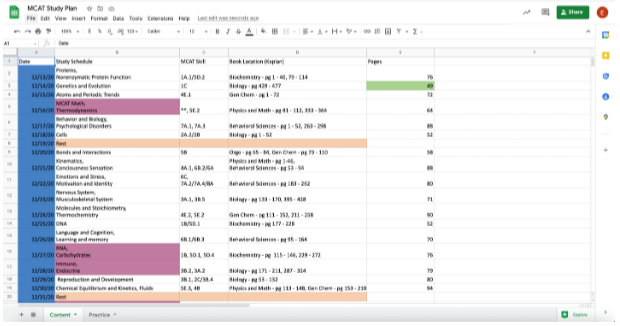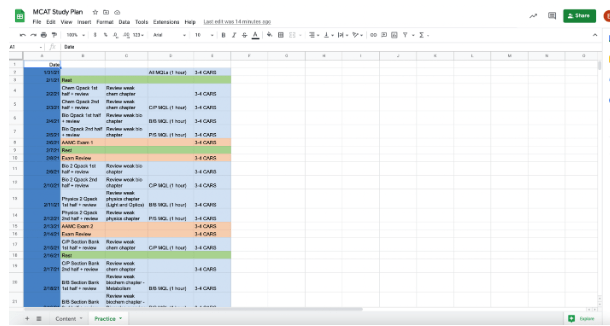Getting into medical school is a long and arduous process. A well-rounded application takes years to craft and includes a variety of endeavors from volunteering to clinical practice to a solid GPA. A crowning piece of any application, however, is your MCAT score. Though it’s possible to attend a great medical school without a top-notch MCAT score, it’s undoubted that a high score can get your foot in the door and make people take a second look at your application. I took the MCAT in March 2021, and what I immediately came to realize is that there is a multitude of resources that one can utilize from MCAT prep courses to content books from different companies to the official AAMC MCAT materials.
I felt overwhelmed with all the options that were available to me but during the process of preparing for the MCAT, I was able to identify 2 things about myself:
- I needed a plan and I don't want to hire an MCAT tutor. I was not the type of person who could work with no end goal in mind. I needed a checklist and study guide. I wanted to know if I was ahead or behind in my prep. I wanted to know that, if I stuck to my schedule for my study time and determine the amount of time I need for the full-length practice tests, I would cover everything I needed to cover.
- I wanted to do it on my own time. I didn’t want to take a prep class or rely on other people’s schedules. I wanted to study when I was in the mindset to study, get ahead if I could, or take time off if I felt burnt out and give my best so I don't have to do a retake.
With these 2 pieces of information in mind, I set out to create my template and study materials - flashcards, a spreadsheet/ checklist/ pacing guide Excel sheet of every Type A academic’s dream. I opened that spreadsheet on December 13th, my first day of studying, and didn’t close it down until I walked out of the testing center on March 13th. It was my Bible, my guide, and, at times, my worst enemy, but it allowed me to navigate the 3-month lead-up to my exam.
And if there’s one thing I believe in, it’s sharing the love, so I’m going to tell you all now how I created my personal self-paced MCAT prep course, which launched me to the 99th percentile
a score of my dreams.
Creating Your MCAT Study Schedule
Before you can even begin to create your MCAT study schedule, you need to know 2 things:
- When do you want to take your exam? and
- How long do you feel you will need to prepare for the MCAT?
These decisions are influenced by multiple factors: when you’re applying to med school, what other obligations or extracurricular activities you have, and how much exposure you’ve had to the content already.
I chose a 3-month test prep period because I had already taken most of my pre-med courses and was also still in college. I chose March 13th as my MCAT test date because this would allow the bulk of my studying to occur over winter break when I wouldn’t be in classes. I knew the last 6 weeks would be a balancing act with my senior year courses, but I wanted to start out my studying with full focus and concentration.
Then, over the course of November, I went about creating my schedule. I started by ordering a full set of Kaplan MCAT Prep books. I choose them because they were recommended as the best books for getting an overview of everything without too much detail to being distracting. In the creation of my schedule, I used Shemmassian consulting’s 3-month study schedule as my baseline. This schedule broke the 3-month time period into a content phase and a practice phase.

The First 6 Weeks of Studying for the MCAT: Content
For the content phase, I went through my Kaplan MCAT books and correlated the Kaplan chapters to their appropriate content category. I then started my spreadsheet.
For each day, I listed the content area recommended by Shemmassian in one column, the MCAT Skill code in the next column, the corresponding Kaplan pages in the third column, and the page total in the fourth column. You can see an excerpt of what the spreadsheet looked like below:

On my first go-around, what I noticed is that my page numbers were VERY off. I had some days with 180 pages and others with 15, so once I had corresponded all the Kaplan books to their respective content categories, my second step became rearranging the chapters, MCAT section, and categories so that it was relatively evenly portioned from day to day.
This is when I should emphasize that the 3-month MCAT schedule is a SKELETON. You can and should adjust it based on what makes the most sense for your lifestyle and your schedule and to avoid burnout. You’ll notice above that I studied on Christmas Day, but originally that was a 90-page day, so I swapped it out for a lighter load in order to spend most of the day with my family. Additionally, I went on a ski trip towards the end of these 6 weeks, so I moved around some rest days and put some 40-page days on those dates so that I could enjoy the trip with relatively little interruption. I didn’t hesitate to adjust the schedule when needed.
Even with this flexibility, this spreadsheet was incredibly grounding for me. I knew exactly what pages I needed to take notes on that day. I knew the MCAT Skills I should’ve covered up to the point, and I could tell if I was getting off schedule.
By the end of this 6-week period, I had read all of the Kaplan books from cover to cover and created a notes guide that touched on every single MCAT skill, and taken all of the multiple-choice quizzes in the books. It was time to move on to the practice phase.
The Second 6 Weeks: MCAT Practice
Shemmassian’s schedule structures its MCAT practice tests phase based on the official AAMC materials, including section banks, question packs, and practice tests. Fortunately, these were the materials that I decided to use, and I strongly recommend you use them as well. I believe the MCAT is a little bit like a game, and to succeed you must know how to play by the rules. The best way to do that is by going straight to the source. I wanted to see as much AAMC full-length practice material as I could in my practice phase so that I could get the closest approximation to test day.
Below is how I adjusted and structured my Excel sheet in the practice phase. This spreadsheet was much more of a checklist. In the first column were the new questions I wanted to tackle. In the second column was content review, in the third column was missed question review and in the 4th was my CARS practice.

As I finished a task, I highlighted the box in blue, and I knew I was done for the day when the whole row was highlighted. At this time, it’s worth noting that I had started my spring semester, so having this checklist allowed me to move right into the priority items of the day in between classes, work, and homework for other subjects.
I think it’s important to be candid about the MCAT prep process, so I’ll take this time to say the first week of my practice phase was like a punch in the face. I had just come off a pure content review and the MCAT format was NOTHING like the discreet questions I had been doing in my studying. I cannot emphasize enough how important it is to have a pure practice phase. As I said before, the MCAT is a game. By doing extensive practice, you not only review content by consistently quizzing yourself, but you also learn the rules. You learn to spot distractor answers, you learn keywords, and you learn how to pace yourself and build stamina. I took 5 full-length practice exams over my 6 weeks, and I know if I hadn’t done that, test day may have been insurmountable for me.
Leading Up to Test Day
My last 2 weeks were planned out on this spreadsheet the same as the rest of my practice phase, but I’ll be honest again and say I went a little rogue.
By the time you get to your final weeks before the test-taking, the best thing that you can do is trust yourself. I knew that my weakest section was Psychological and Social Sciences, so, while my schedule had an even distribution of reviews across all sections, I dove headfirst into Anki, Khan Academy, and AAMC P/S Reviews. And in the end, it paid off. I saw a 4-point jump from my highest P/S practice score to my exam day score.

The Bottom Line
So you just read this whole long guide on how I got through my 3-month MCAT prep (or maybe you just scrolled to the bottom to see if there’s a summary). Well, if the second is true, you’re in luck. In order to successfully guide yourself through an independent MCAT prep, you need three things: very disciplined study habits, rigorous planning, and the grace to offer yourself flexibility.
First, you have to know what you need to get done each and every day because 3 months may feel like a long time, but truthfully, it flies. Without a day-by-day plan, you could find yourself falling behind or missing content.
But you know what they say about the best-laid plans. Life, school, work, social endeavors: you can never really anticipate what your life will look like, so don’t be afraid to move things around to give yourself a day off. Spend a little more time with the chapter that’s tripping you up. Give yourself a day to do a CARS extravaganza. Because at the end of the day, you know what needs to get done and you have to trust yourself to get there.







